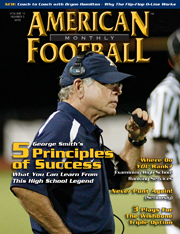Article CategoriesAFM Magazine
|
Simplicity and the O-Line – Why The Flip/Flop O-Line Worksby: Paul HoffmanOffensive Line Coach Loras College © More from this issue As coaches, we tend to overthink and overestimate our influence on game days. The common trap is our attempt to outcoach our adversaries across the field. While giving a clinic two years ago, I had an epiphany: “It is not my job to outcoach someone. It is my job to get my men to outplay their opponents.” On game day, it does not matter what we know. It’s what our players know that determines the outcome. This became my motto in everything I do as an offensive line coach and I am blessed enough to coach with others that agree with this position. It became our staff goal to apply a few rules as we set up our offense and continued its development throughout the season. Loras College Offensive Philosophy 1. Does it fit our system?
|
|
|||||||
| HOME |
MAGAZINE |
SUBSCRIBE | ONLINE COLUMNISTS | COACHING VIDEOS |
Copyright 2026, AmericanFootballMonthly.com
All Rights Reserved





